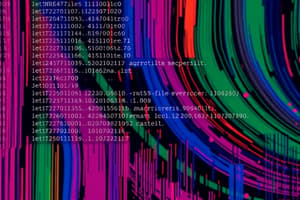Podcast
Questions and Answers
What is the primary purpose of batch normalization in artificial neural networks?
What is the primary purpose of batch normalization in artificial neural networks?
- To improve the learning speed by adjusting weights more frequently
- To increase the batch size for training efficiency
- To minimize the complexity of the neural network architecture
- To enhance the stability of the network and reduce sensitivity to overfitting (correct)
What does the keep probability (p) represent in the dropout technique?
What does the keep probability (p) represent in the dropout technique?
- The probability that a node will be retained during training (correct)
- The probability that a node will be completely ignored during training
- The probability that the network remains sensitive to all input features
- The probability that all nodes are activated in every iteration
In the context of neural networks, what is an epoch?
In the context of neural networks, what is an epoch?
- A complete cycle in which the network has processed the entire dataset once (correct)
- A measure of the total amount of data processed in a single training session
- The average number of training examples used per iteration
- The total number of iterations during which weights are updated
What is the effect of regularization in machine learning?
What is the effect of regularization in machine learning?
Which of the following is a drawback of multilayer artificial neural networks?
Which of the following is a drawback of multilayer artificial neural networks?
What is the main function of the dropout technique in training neural networks?
What is the main function of the dropout technique in training neural networks?
How is the batch size defined in the context of neural network training?
How is the batch size defined in the context of neural network training?
What might be a consequence of using a batch size that is too large during training?
What might be a consequence of using a batch size that is too large during training?
What is one limitation that multilayer artificial neural networks face during training?
What is one limitation that multilayer artificial neural networks face during training?
In the context of regularization in machine learning, what is its main purpose?
In the context of regularization in machine learning, what is its main purpose?
Flashcards
Batch Normalization
Batch Normalization
A technique used in artificial neural networks (ANNs) that involves normalizing the inputs of each layer by re-centering and re-scaling them. This helps stabilize the training process and reduces overfitting.
Dropout
Dropout
A technique used in ANNs to prevent overfitting by randomly dropping nodes or connections during training. This forces the network to become more robust and less reliant on specific features.
Batch Size
Batch Size
The size of the training dataset used in each iteration of the learning process. It determines how many examples are used to update the network's weights in each step.
Epoch
Epoch
Signup and view all the flashcards
Regularization
Regularization
Signup and view all the flashcards
What is batch normalization?
What is batch normalization?
Signup and view all the flashcards
What is dropout?
What is dropout?
Signup and view all the flashcards
What is batch size?
What is batch size?
Signup and view all the flashcards
What is an epoch?
What is an epoch?
Signup and view all the flashcards
What is Regularization?
What is Regularization?
Signup and view all the flashcards
Study Notes
Batch Normalization
- Batch normalization (batch norm) is a technique used to stabilize artificial neural networks, making them less sensitive to overfitting.
- It normalizes layer inputs by re-centering and re-scaling.
- Proposed by Sergey Ioffe and Christian Szegedy in 2015.
Dropout
- Dropout removes some nodes during training to prevent the network from being overly reliant on specific nodes.
- Nodes are kept or removed with a specified probability (keep/drop probability).
- The technique aims to prevent the NN from being overwhelmed by information, especially if some nodes might be redundant and useless.
Batch Size
- Batch size is the training dataset size used per iteration.
- For example, a batch size of 4 means 4 training examples are used per iteration.
- Also known as mini-batch size.
Epoch
- An epoch is a complete pass through the entire training dataset.
- If batch size is 128 and dataset size is 2048, one epoch requires 16 iterations (2048/128=16).
- The number of iterations divided by the iterations per epoch equals the number of epochs.
Regularization
- Regularization adds information to solve ill-posed problems or prevent overfitting, usually modifying the objective/cost function.
- Example: L1 regularization.
Multilayer Artificial Neural Networks (ANN)
- Multilayer ANNs are universal approximators.
- They can overfit if the network is too complex.
- Gradient descent might converge to local minimum.
- Training can be time-consuming, but testing is often fast.
- ANNs can handle redundant attributes because weights are automatically learned.
- ANNs are sensitive to noise in training data.
Studying That Suits You
Use AI to generate personalized quizzes and flashcards to suit your learning preferences.





